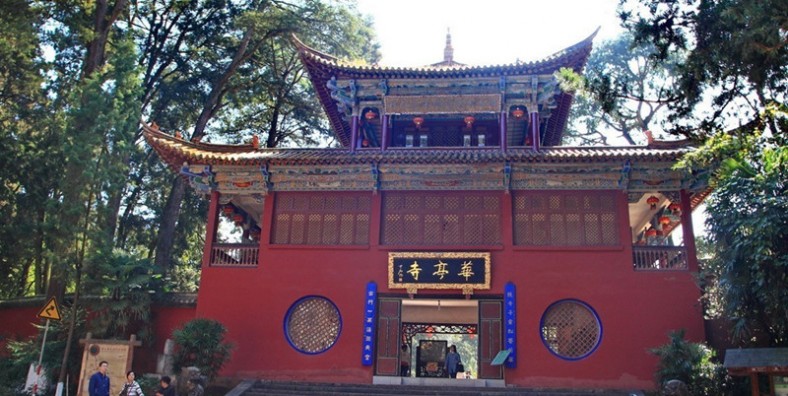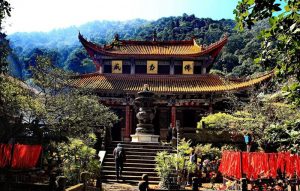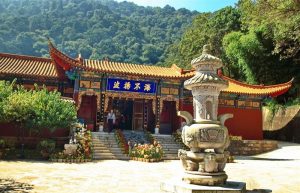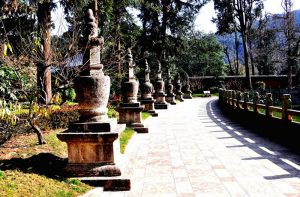
Huating Temple in Kunming

Chinese Name: 华亭寺
Chinese Pinyin: Hua Ting Si
English Name: Huating Temple
Type: Buddhist Temple, Cultural & Historical Landscape
Best Seasons: All year round
Recommended Visiting Time: 1 hour
Tickets: ¥6
Opening Hours: 8:30am -17:00pm
Location: Centre of Xishan Scenic Resort in Xishan District, Kunming
Why is Huating Temple so special?
Huating Temple is located at Xishan Mountain Forest Park in Xishan District, Kunming City, Yunnan Province. Different from other temples, it faces east not south. The temple was frist built in 1063, during Song Dynasty, covering an area of 12,000 square meters in rectangle. The temple is axisymmetric and closed courtyard type. Huating Temple is the largest temple in Yunnan province. It was released as one of the kunming municipal cultural relics protection units.
Introduction

The History of Huating Temple
Yuan Dynasty
The temple was first established by Xuantong Yuanfeng (玄通元峰) in 1320, during the mid-Yuan dynasty (1271–1368). The construction was completed in 1334. In 1339, Xuantong Yuanfeng brought a set of Chinese Buddhist canon to the temple after he visited Jiangnan. At that time it initially called “Yuanjue Temple” (圆觉寺).
Ming Dynasty
In 1441, Emperor Yingzong of the Ming dynasty (1368–1644) renamed it “Huating Temple” (华亭寺). This name has been used to date. In 1453, Emperor Yingzong sent an eunuch named Li Yi (黎义) to renovate and redecorate the temple.
After the fall of the Ming dynasty, Huating Temple was devastated by wars.
Qing dynasty
In 1687, during the reign of Kangxi Emperor (1662–1722) of the Qing dynasty (1644–1911), the provincial governor of Yunnan Wang Jiwen (王继文) rebuilt the temple.
In 1857, in the Xianfeng era (1851–1861), Part of the temple was badly damaged in the Hui Uprising.
Huating Temple was restored in 1883 with a small-scale.
Republic of China
In 1920, Military Governor of Yunnan Tang Jiyao invited Hsu Yun to disseminate Buddhism. Hsu Yun supervised the reconstruction of Huating Temple.
People’s Republic of China
In 1969, the Buddhist Texts Library became dilapidated for neglect. It was demolished in the following year.
Huating Temple has been designated as a National Key Buddhist Temple in Han Chinese Area by the State Council of China in 1983.
Sturcture of Huating Temple
The architecture style of the Huating Temple is deeply affacted by palace style rule and Confucian culture. Along the central axis of the whole temple, there are Free Life Pond, Hall of Heavenly King, Eight Merit Pool, Mahavira Hall and Depository of Buddhist Sutras.
What to See in Huating Temple

Along the lateral axis from Mahavira Hall, there are scripture hall, ancestor’s hall, abbot’s quarter, Sengtang, living room, bath house, warehouse and so on. And the Mahavira Hall is the center of the temple.
Architecture
The Mahavira Hall: Along the central axis are the Four Heavenly Kings Hall, Mahavira Hall, Guanyin Hall and Buddhist Texts Library: There are over 10 halls and rooms on both sides, including Guru Hall, Abbot Hall, Monastic Dining Hall, Monastic Reception Hall and Meditation Hall.
Four Heavenly Kings Hall: Statues of lion and elephant stands in front of the Four Heavenly Kings Hall. On both sides of the hall there are the statues of Heng and Ha. In the center of the hall enshrines the statues of Maitreya Buddha and Skanda. Statues of Four Heavenly Kings are enshrined in the left and right side of the hall.
Mahavira Hall: The Mahavira Hall enshrining the statues of Sakyamuni, Amitabha and Bhaisajyaguru. In front of Sakyamuni stand Ananda and Kassapa Buddha on the left and right. At the back of Sakyamuni’s statue are statues of Guanyin and Twenty-four Gods of Heaven. Totally 500 niches with small statues of Arhats are carved on both sides of the bounding walls.
Other Attractions

The Bell Tower: The gate of Huating Temple is a high and grand Bell Tower withcornices and old trees there. There is a pool with lots of fish in it. In summer, the white and red lotus are very beautiful in the pond.
Eight Merit Pool: Out of the Heavenly King Hall, you will enter a two layer courtyard, the lower layer is small and exquisite. There is a stone bridge on the Eight Merit Pood which divides the pond into two parts. There are rockery and fishes in the pond. There are also planted wisteria purple, podocarpus, camellia, ginkgo, magnolia. Under the rattan shade, there are stone tables for visitors to have a rest. The upper courtyard stand a giant stone incense burner in the midlle. Incense smoke all day, giving a sense of vulgarity.
What to Do in Huating Temple?
1. Exploring Buddhism Culture
The Huating Buddhist Temple is an ancient Buddhist temple that was originally a retreat for the local ruler. Sitting at the foot of Mount Huating, it is one of the best-preserved Buddhist temples in Kunming. The main temple contains a trinity of gilded lacquer Buddhas seated on lotus thrones. It is characterized by blue hair, august gesture and sumptuous setting.
2. Tying Wishing Red Ribbon
Tourists can buy a red ribbon in Huating Temple, then make a wish, tie the red ribbon on the tree, pray for the wish to come true.
3. Watching Plants
The temple is famous for its rare flowers and trees. Many camellia, magnolia, sweet-scented osmanthus and others trees were planted in and outside the temple, made the temple the best place to enjoy the flowers.
How to Get there?
By Bus
People can take public bus No.6, 17, 18, 21, , 51 and 94 to Xinshan Park Station, then walk to Huating Temple.
By Taxi
A taxi to the temple entrance from downtown of Kunming should cost roughly 50 yuan.
Travel Tips
1. Visitors are advised to always carry changes of clothing due to the large variations in temperature between day and night.
2. The climate is relatively dry, so drink more water every day.
3 Protecting oneself from strong UV radiation at high altitude.
4. Protecting oneself from altitude sickness. Lessen the effects of altitude sickness, avoid strenuous exercise and have plenty of rest.
5. Respect local customs , habits, and religious beliefs.

 7 Days GolfingTour
7 Days GolfingTour
 8 Days Group Tour
8 Days Group Tour
 8 Days Yunnan Tour
8 Days Yunnan Tour
 7 Days Shangri La Hiking
7 Days Shangri La Hiking
 11 Days Yunnan Tour
11 Days Yunnan Tour
 6 Days Yuanyang Terraces
6 Days Yuanyang Terraces
 11 Days Yunnan Tour
11 Days Yunnan Tour
 8 Days South Yunnan
8 Days South Yunnan
 7 Days Tea Tour
7 Days Tea Tour
 8 Days Muslim Tour
8 Days Muslim Tour
 12 Days Self-Driving
12 Days Self-Driving
 4 Days Haba Climbing
4 Days Haba Climbing
 Tiger Leaping Gorge
Tiger Leaping Gorge
 Stone Forest
Stone Forest
 Yunnan-Tibet
Yunnan-Tibet
 Hani Rice Terraces
Hani Rice Terraces
 Kunming
Kunming
 Lijiang
Lijiang
 Shangri-la
Shangri-la
 Dali
Dali
 XishuangBanna
XishuangBanna
 Honghe
Honghe
 Kunming
Kunming
 Lijiang
Lijiang
 Shangri-la
Shangri-la
 Yuanyang Rice Terraces
Yuanyang Rice Terraces
 Nujiang
Nujiang
 XishuangBanna
XishuangBanna
 Spring City Golf
Spring City Golf
 Snow Mountain Golf
Snow Mountain Golf
 Stone Mountain Golf
Stone Mountain Golf














